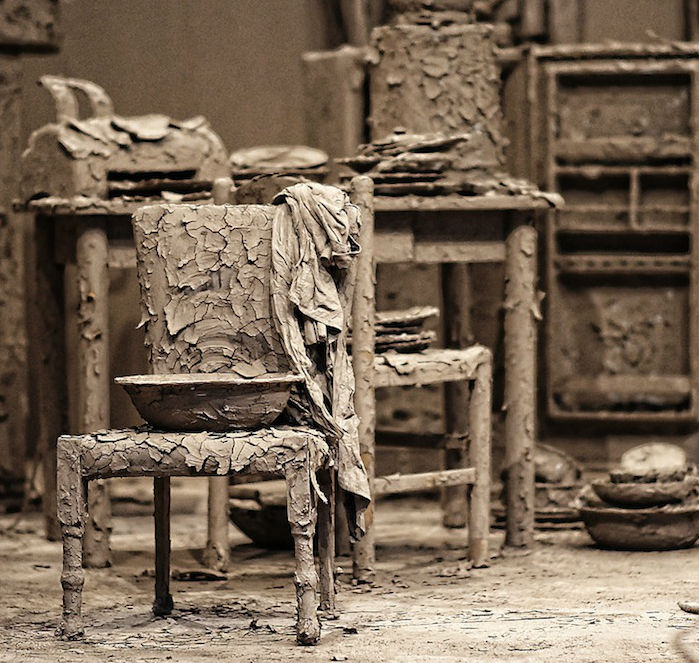Chinese artist Chen Zhen (1955–2000) is recognized as one of the most influential Chinese artists of the last 30 years. His work is rooted deeply in his personal experiences working across continents and coping with a terminal blood disease diagnosed at the age of 25 (at the time he was given just 6 years to live). His sculptures elicit a deep emotional connection, stirring an unavoidable empathy through universal human experiences. Zhen passed away in 2000 at the age of 45. His work is still shown frequently thanks to the work and passion of his widow Xu Min who continues to organize exhibitions and push his career forward, which has not slowed since his death. His installation Purification Room has been recreated repeatedly since its debut in 2000. It is a conceptually layered installation made using everyday objects covered in clay about the cyclical nature of things we often perceive narrowly as permanent.
Above Image: Chen Zhen, Purification Room, 2000. Photo Credit: .Genc0.

Chen Zhen, Purification Room, 2000-2015, Private Collection, Paris, Courtesy GALLERIA CONTINUA, San Gimignano / Beijing / Les Moulins, Chen Zhen ©, ADAGP, Paris – SACK, Seoul, 2015 Photo provided by Rockbund Art Museum
The Purification Room puts time in perspective, refocusing our perception of the lifespan of people, objects, and environments. Considering Zhen’s illness and death shortly following the debut of this piece, the installation could be looked at as self-assuring Zen environment, reducing a familiar space to monochromatic, lifeless, timeless dirt, and refocusing thoughts to one’s own vitality, temporarily and basic origins. The work takes death, inevitable, but oddly haunting and alienating when the clock is exposed, and layers it over everyone and their individual experiences. The Purification Room kills the viewer, the only element missing from the domestic space, presumably covering them in the same apocalyptic dust that’s drowning the rest of reality as we know it. This is not a grim installation though, maybe more of a personal apocalypse. An imagining of what happens, what it feels like, to be moments after death – dull, senseless, calm, elemental, reclaimed.
In 2008 Zhen’s widow, Xu Min, spoke to Design Boom at the Mart Museum in Rovereto, Italy, about her late husband and what it means to recreate the Purification Room:
“The natural material I use helps figure out the source which the objects come from as well as the place where they will go back after their circulation through the society. The purifying elements sacrifice those objects after their utilisation, and sublimate a latent spirit; they provoke a new destiny to the fatal conclusion of these objects.”
Xu Min continues, “I rely on the experiences of working next to my husband Chen Zhen, for almost ten years. he influenced me a lot and we discussed a lot. I have kind of slowly entered into the sense of … not only putting on an exhibition but also, most importantly, I sense how to release the energy of Chen Zhen’s work. After the death of my husband, I sense it even more. I feel a heavy responsibility to engage in his thoughts on simple presentation. I try to not to forget what he wanted to say and now this energy flows through me, sometimes it’s through my hands directly, but its up to me to do justice.”

Chen Zhen, Purification Room, found objects, clay, 850 x 1100 x 450 cm, 2000-2015, Private Collection, Paris, Courtesy GALLERIA CONTINUA, San Gimignano / Beijing / Les Moulins © Chen Zhen, ADAGP, Paris – SACK, Seoul, 2015, Photo Sebastiano Pellion di Persano. Click to see a larger image.
How did Chen Zhen’s sickness impact his art?
“The disease influenced his work, but he transformed it into a positive thing,” Xu Min explained to Design Boom. “He worked non stop because he wanted to develop an important subject. He wanted to become a doctor and he treated his body as a laboratory. He wanted to heal himself but also heal the world. Because the world and the body are linked. He wanted to develop this subject as a subject of life. If he were still living, I think he would be developing lots of projects in this sense. He always worked in this relation between man, society and nature. The societal sickness – It’s a mental sickness. Chen Zhen had many worries for this. Before anything, you have to heal the mentality, heal the problems, society and nature.” (Read the full interview here)
The Purification Room has been recreated around 10 times since his death in 2000 including in the Galleria Continua; Beijing, The Mart Museum; Italy, and most recently at the Rockbund Art Museum (RAM) in Shanghai (May 30 – October 7, 2015). You can see some of the many iterations of the piece below.
Justin Crowe is a Writer and Director of Operations at cfile.
What do you think of Chen Zhen’s Purification Room and Xu Min’s efforts to recreate it? Tell us in the comments below!

Chen Zhen, Purification Room, 2000, Pinchuk Art Centre, Group Show “China China” (2013), found objects and clay. Click to see a larger image.

Chen Zhen, Purification Room, found objects, clay, 850 x 1100 x 450 cm, 2000-2015, Private Collection, Paris, Courtesy GALLERIA CONTINUA, San Gimignano / Beijing / Les Moulins © Chen Zhen, ADAGP, Paris – SACK, Seoul, 2015, Photo Sebastiano Pellion di Persano

Chen Zhen, Purification Room, 2000, objets-trouvés, clay, 260 x 600 x 530 cm © Courtesy of the artist & Galleria Continua – San Gimignano.

Chen Zhen, Purification Room, 2000.

Chen Zhen, Purification Room (detail), 2000.

Chen Zhen, Purification Room (detail), 2000.





Add your valued opinion to this post.